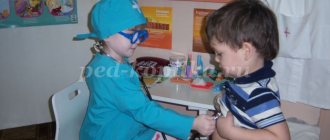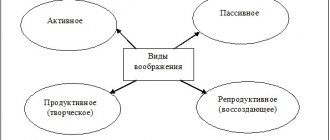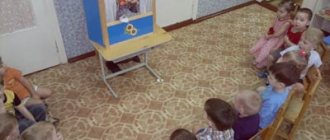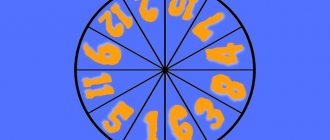The structure of the game and the stages of its development.
Section 1. Theoretical and methodological foundations of play activities for children of early and preschool age
Psychological and pedagogical substantiation of the essence of the game and its development in childhood
Children's play is the activity of a child in a conditional (imaginary, imaginary) situation. The motive for such activity lies within itself, that is, the child plays not for the sake of some external result or effect, but because he wants to play. As soon as this motive changes, the game ceases to be a game.
Play arises from the child's living conditions in society and reflects these conditions. In it, “primary orientation in the meanings of human activity occurs, a special knowledge of one’s limited place in the system of relations among adults and the need to be an adult arise.” (D.B. Elkonin)
From early childhood, adults introduce the child to the surrounding reality and, in the process of communication, convey to him certain experience and knowledge regarding actions with objects and relationships with people. Consolidation of elementary experience and reflection of first ideas occurs in the game, which is extremely important for the full development of preschool children.
In the works of L.S. Vygotsky (1896–1934), play is already recognized as a leading activity, that is, determining the development of a child. At what point does it appear and when does it become the leading activity? A young child can only learn something by actually touching, tasting, and experiencing it. Actions “in the mind” are not yet available to him, but the younger schoolchild is already capable of them. Where does this “mind” come from and when does it arise, or, in scientific terms, the internal plan of activity? It is formed precisely in the game and through the game! The initially developed play actions are replaced by a gesture, then by a word, and then begin to be carried out entirely in the mind (fantasy play). In addition, only in a game the meaning of an object is divorced from the thing itself. All other activities of the child are real. And in the game you can only act by the meaning, and not by the object itself. The ideal and the material are separated. An ideal action arises, the foundations of theoretical thinking are born, and (according to A.V. Zaporozhets) the ground floor of the general building of human thinking is laid. This is the main significance of the game for the mental development of children .
One of the largest game researchers of our time, S.L. Novoselova, gave both a very figurative and very precise definition: a game is “a form of practical reflection by a child about the reality around him,” which is “a genetic prototype of an adult’s theoretical thought.” . In the game practically, that is, in action, the whole world becomes available. A preschooler cannot drive a car, let alone a spaceship, get into the jungle or the North Pole overnight, and even more so, find himself in the past or future. All this is possible in the game.
Play is of enduring importance for the social development of a child; it is in play that he tries on role behavior and begins to understand many of the nuances of human behavior. He learns to subordinate his behavior to certain rules, this means that without full-fledged play he will not develop such an important quality as the arbitrariness of his activities. According to the famous psychologist L.I. Bozhovich, play is the mechanism that translates the demands of an adult into the needs of the child himself. But play is not only the practical development of “future” adult relationships as a result of playing one’s role well. In the process of gaming activity, real interaction with a peer is built: the ability to negotiate, listen to the other, sometimes compromise, sometimes insist on one’s own so that the game can continue, and most importantly, that it be interesting and exciting for everyone!
There are other extremely important properties that are formed in a preschooler’s amateur play - activity and initiative. To maintain an interesting, exciting game, a child needs to use all his imagination, be able to play with any little detail, find a way out of any situation in case of difficulty, model and experience different versions of the situation in action. A child who has gained experience of such a variable approach to different problems in play easily transfers it to other types of activities, and the “underplayed” one is very often truly afraid of making a mistake.
Unfortunately, educators do not always pay due attention to gaming activities, and many parents simply do not know about the developmental potential of the game and its role in the life of preschool children, often giving greater preference to foreign languages, reading, writing, rhetoric and even philosophy. Indeed, the more a child knows and can do, the more favorable conditions he will be in comparison with his peers. However, we can teach a child as much and as much as we want, but what of this will be learned?
Vygotsky L.S., who was called the Mozart of psychology (he very accurately anticipated many things that were later confirmed experimentally), said that if a young child is incapable of learning according to an adult’s program, then a schoolchild is fully capable of it. A preschooler is able to learn according to an adult’s program only to the extent that this program becomes his own.
What is the role of play here?
The game form makes many tasks for the child interesting and understandable, which is often used in didactics, but, oddly enough, this is not the main thing. Firstly, in amateur children's play , which arises on the initiative of the child himself, those mental qualities are formed without which learning will simply be impossible. Secondly, in the game, children get the opportunity to use the acquired knowledge in practice, and therefore truly assimilate and understand it. Without such practical testing, any knowledge becomes abstract, unnecessary and quickly forgotten. For the development of a preschooler, those games that come from him, his own initiative, the plot of which he invents himself - role-playing or director's - are important. It is in them that general development occurs to the greatest extent, and not where any individual functions are exercised.
They do not appear out of nowhere. Any other games in which an adult is the initiator are grist to the mill for the development of amateur play. It is important that the child masters the gaming culture in all its diversity: in early and early preschool age, these are plot-based games (the child repeats what he sees around), then amateur plot games appear (the child turns to plots that are interesting to him, invents themselves), by older preschool age games with rules are added here. One should not underestimate such types of games as leisure, active, experimental games, and various folk games. A good children's game is an emotionally rich action in which the child is completely immersed. The wider the range of events and phenomena displayed in the game, the better. So, if the youngest preschooler willingly plays in the store and clinic, in the family and kindergarten, then the games of older preschoolers are much more exciting, they are associated with travel, adventures and exploits. Gradually, the game acquires a “multi-aspect” character: the child not only invents and develops a plot (this can happen over a fairly long period of time: from several days to several weeks and even months), but also actively includes in his game everything that, in one way or another otherwise, it affects him (new knowledge, new objects, new characters). He actively constructs the subject environment of his game (if we are talking about a director's game) or some of its attributes (if the game is a role-playing game). Here the game is so closely linked with productive activities that it is almost impossible to distinguish between them. Visual activity and creative work become truly motivated - significant for the child himself, enriching his skills and generalizing his experience, and the process of creating toys, although it slows down the play action in time, often opens up new opportunities for constructing a plot.
Game is the most powerful sphere of a person’s “self”: self-expression, self-determination, self-test, self-rehabilitation, self-realization. Thanks to games, a child learns to trust himself and all people, to recognize what should be accepted, what should be accepted, and what should be rejected in the world around him.
It’s not for nothing that the game is called the queen of childhood. The famous scientist E. Berne said that he views the entire process of raising a child as learning what games to play and how to play them.
Game is a complex and multifaceted phenomenon. The following functions can be distinguished:
The educational function is the development of general educational skills and abilities, such as memory, attention, perception, etc.
The entertainment function is creating a favorable atmosphere in the classroom, transforming a lesson and other forms of communication between an adult and a child from a boring event into an exciting adventure.
The communicative function is to unite children and adults, establish emotional contacts, and develop communication skills.
Relaxation function – relieving emotional (physical) stress caused by the load on the child’s nervous system during intensive study and work.
Psychotechnical function - the formation of skills to prepare one’s psychophysical state for more effective activity, the restructuring of the psyche for intensive assimilation.
The function of self-expression is the child’s desire to realize his creative abilities in play and to more fully reveal his potential.
The compensatory function is the creation of conditions for satisfying personal aspirations that are impossible (difficult to achieve) in real life.
There are different types of games typical for children. These are outdoor games (games with rules), didactic games, dramatization games, constructive games . Creative or role-playing are of particular importance for the development of children aged 2 to 7 years . They are characterized by the following features:
1. The game is a form of active reflection by the child of the people around him.
2. A distinctive feature of the game is the very method that the child uses in this activity. Play is carried out through complex actions, rather than individual movements (as, for example, in labor, writing, drawing).
3. The game, like any other human activity, has a social character, so it changes with changes in the historical conditions of people's lives.
4. Play is a form of creative reflection of reality by a child. While playing, children bring a lot of their own inventions, imaginations, and combinations into their games.
5. Play is the manipulation of knowledge, a means of clarifying and enriching it, a way of exercise, and the development of the child’s cognitive and moral abilities and strengths.
6. In its expanded form, the game is a collective activity. All participants in the game are in a cooperative relationship.
The structure of the game and the stages of its development.
The main structural elements of the game are: the game concept, plot or content; game actions; roles; rules that are dictated by the game itself and are created by children or proposed by adults. These elements are closely interrelated.
Game design is a general definition of what and how children will play. It is formulated in speech, reflected in the game actions themselves, formalized in the game content and is the core of the game. According to the game concept, the games can be divided into groups: those reflecting everyday phenomena (games of “family”, “kindergarten”, “clinic”, etc.); reflecting creative work (construction of the metro, construction of houses...); reflecting social events, traditions (holidays, meeting guests, travel, etc.). This division of them, of course, is conditional, since the game can include a reflection of various life phenomena.
The plot, the content of the game is what makes up its living fabric, determines the development, diversity and interconnection of game actions, and the relationships between children. The content of the game makes it attractive, arouses interest and desire to play.
The structural feature and center of the game is the role played by the child. Based on the significance of the role in the game process, many of the games are called role-playing or role-playing. The role is always related to a person or an animal; his imaginary actions, actions, relationships. The child, entering their image, plays a certain role. But the preschooler does not just play this role, he lives in the image and believes in its truthfulness. Depicting, for example, a captain on a ship, he does not reflect all of his activities, but only those features that are necessary during the course of the game: the captain gives commands, looks through binoculars, takes care of passengers and sailors. During the game, the children themselves (and in some games, adults) establish rules that define and regulate the behavior and relationships of the players. They give games organization and stability, consolidate their content and determine further development, the complication of relationships and relationships.
The role is realized in play actions , which initially reproduce real actions, but as the child develops, they become increasingly generalized and abbreviated while maintaining the logic and sequence of their implementation. In the future, they can move to the internal plane through the stage of their speech performance (the child no longer acts with a game object, but talks about the action).
The playful use of objects can be realized both in the form of the use of figurative toys (objects that are a small copy of real things, specially created by society to organize a child’s play), and in the form of replacing some objects with others (with appropriate renaming). Substitution is the most important characteristic of a role-playing game.
And finally, another component of the structure of a role-playing game is the real relationship between playing children as partners in joint play activities. The functions of real relationships include planning the plot of games, distributing roles, game items, monitoring the development of the plot and the fulfillment of roles by peer partners, and their correction. If play relationships are determined by the content of the roles children perform, then their real relationships depend on the characteristics of personal development.
All of these structural game elements are more or less typical, but they have different meanings and are related differently in different types of games.
How does play develop throughout preschool childhood?
The famous psychologist D.B. Elkonin (1978) linked the development of play with the dynamics of child development. The development of play in children goes through four stages.
First stage . The main content of the game is actions with objects. They are carried out in a certain sequence, although this sequence is often disrupted. The chain of actions is plot-based. The main subjects are everyday ones. The actions are monotonous and often repeated. The roles have not yet been designated. At the first stage of role-playing play, preschoolers willingly play with adults. Independent play is short-lived. As a rule, the stimulus for the emergence of a game is a toy or a substitute item previously used in the game.
Second phase. As at the first level, the main content of the game is actions with an object. However, now these actions unfold sequentially, in accordance with the role, which is already denoted by the word. The sequence of actions becomes the rule. The first interaction between the participants occurs based on the use of a common toy. Associations of players are short-lived. The main subjects are everyday ones. The game is repeated many times. Children use the same toys – their favorite ones. The game involves 2-3 people.
Third stage. The main content of the game is still actions with objects. However, they are complemented by actions aimed at establishing contacts with playing partners. Roles are clearly defined and assigned before the game begins. Toys and objects are selected (most often during the game) in accordance with the role. The logic, nature of actions and their direction are determined by the role and become the basic rule. The game often proceeds as a joint game, although interaction is interspersed with parallel actions of partners who are not related to each other and are not correlated with the role. The duration of the game increases. The plots become more diverse: children reflect in the game not only everyday life, but also the work of adults, vibrant social phenomena.
Fourth stage. The main content of the game is a reflection of the relationships and interactions of adults with each other. The themes of the games are varied: it is determined not only by the direct, but also by the indirect experience of children (playing out scenes from literary works, films, television programs, etc.). Games are joint and collective in nature. Associations of participants are stable. They are based on children’s interest in the same games or on the basis of personal sympathies and affections. Games of the same content are not only repeated for a long time, but also develop, become enriched, and exist for a long time. The game has a preparatory stage: distribution of roles, selection of game material, and sometimes its production (homemade toys). The number of people involved in the game is up to 5-6 people.
At the fourth stage, that is, by senior preschool age, the individual characteristics of each child’s play activity and play creativity are clearly manifested.
Conditions
- Before the start of the game, the teacher plans this activity, sets educational, training and educational tasks.
- During the entire process, the adult remains in charge. He starts the game, clearly explains the rules, follows the unfolding of the plot and sums up the conclusion.
- The teacher takes an active part: he reacts emotionally to moments of the game, and helps the children if necessary.
- He takes into account the individual characteristics of children, changing the course or rules if necessary. Controls the rotation of game roles after the end of each game cycle.
Games in childhood, including didactic ones, are the leading type of human activity and are of great importance for him. Teachers and parents, by correctly implementing them, are able to help children develop and learn unnoticed and natural for their age.









